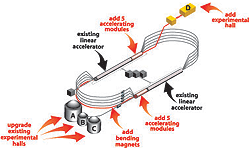2006 News Release
Secretary of Energy Announces Approval and Funding for 12 GeV Upgrade

Schematic of the 12 GeV Upgrade
Additional Information about Jefferson Lab and the 12 GeV Upgrade
The mission of the Department of Energy's Office of Science's Nuclear Physics program at the Thomas Jefferson National Accelerator Facility (Jefferson Lab) is to explore the quark structure of matter. In pursuit of this mission, the Continuous Electron Beam Accelerator Facility (CEBAF) is used to conduct user-driven research into how protons and neutrons inside the nucleus of the atom are built from quarks and gluons.
Already, CEBAF and the three experimental halls have revealed much about how quarks and gluons make up matter. The 12 GeV Upgrade would increase the available energy of the electrons used in these investigations from about 6 billion electron-volts (GeV) to 12. The technical scope of the proposed project includes the accelerator upgrade, a new experimental hall (Hall D) and associated beamline, and upgrades of the three existing experimental halls (Halls A, B, and C). The project will entail a $225-$300 million investment in the facility.
"Congratulations to JLab's 12 GeV Upgrade team for achieving this important milestone, and thank you for an outstanding job. The 12 GeV Upgrade team - Allison Lung, Claus Rode, Leigh Harwood, Will Brooks, Rebecca Yasky, Del Whitlock, their Assistant Project Managers and Senior Team Leaders, Jefferson Lab's Users and the many other people working on the 12 GeV Upgrade project are helping assure the Lab's future," says Lab Director Christoph Leemann, "The Upgrade is an investment in our future. With a strong scientific program and a solid project foundation, we ensure a vital, world-class scientific program at Jefferson Lab for many years to come."
The upgrade will enable researchers to answer one of the most fundamental questions in physics today: why quarks, the building blocks of protons and neutrons, can never be found alone. Additionally, the Upgrade will allow the in-depth study of the proton's mysteries, the balance of forces within nuclei, and quark matter in the first second of the universe. In depth, future investigations with an upgraded CEBAF include:
Quark Confinement
Why are quarks never alone? As two quarks are pulled apart, the strong force that glues them together becomes ever more excited, forming powerful new force fields, "flux tubes," between the quarks. The 12 GeV Upgrade will allow scientists to produce and study exotic or hybrid mesons containing these flux tubes - allowing for a better understanding of the strong force underlying the structure of the atomic nucleus, how it confines quarks, and how it contributes to the structure of everyday matter.
Protons
Much is still unknown about the proton. For instance, why is it the size and shape we observe? The Upgrade will allow researchers to discover the true, three-dimensional structure of protons by accessing, for the first time, experimentally measurable quantities that can be used to map out the location and momentum of the quarks and gluons inside protons and determine their contributions to the proton's physical properties, such as size, shape, spin, and electric and magnetic fields.
Nuclei
Most of the strong force glues quarks into protons and neutrons. But a fraction of this force leaks out, binding protons and neutrons into atomic nuclei. Without this force, nuclei would fly apart. The force that binds is delicately balanced by a force that repels. A nucleus is tightly packed space. When protons and neutrons become even more tightly packed, the force reverses, and they repel each other. If this didn't happen, nuclei would collapse. That nuclei exist at all is one of nature's most remarkable miracles.
Matter
Quarks are never found alone today, but in the first second of the universe, "free" quarks are believed to have been present. Powerful particle accelerators can also produce individual quarks - but almost immediately, quarks and gluons erupt out of empty space to join with the individual quark and form new matter. It will take sophisticated experiments, probing beyond the Standard Model of nuclear physics, to reveal how speeding quarks turn into ordinary matter and provide new insights into the fundamental particles that comprise the world around us.
For more information, please visit:
Related Press Coverage:
- On a Mission for Science (February 23, 2006, Daily Press)
Thomas Jefferson National Accelerator Facility’s (Jefferson Lab’s) basic mission is to provide forefront scientific facilities, opportunities and leadership essential for discovering the fundamental structure of nuclear matter; to partner in industry to apply its advanced technology; and to serve the nation and its communities through education and public outreach. Jefferson Lab, located at 12000 Jefferson Avenue, is a Department of Energy Office of Science research facility managed by the Southeastern Universities Research Association.

